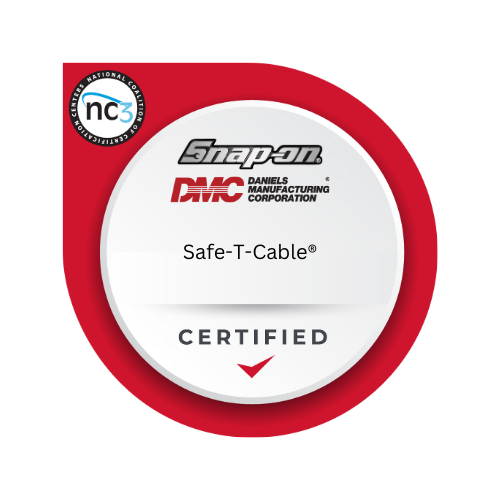Safe-T-Cable Badge Details

Objective
The successful completion of the Daniels Manufacturing Corporation Safe-T-Cable® Certification enables graduates to demonstrate solid understanding of proper safe setup and use of the Safe-T-Cable. The skills acquired during this comprehensive training are valuable TOOLS FOR LIFE that can lead to rewarding careers in the global marketplace. Safe-T-Cable® is the most reliable way to do retention in high-reliability applications in aerospace, land-based and maritime transportation, space exploration, and military defense systems. Compared to the alternatives, Safe-T-Cable® installs faster, with more consistent quality resulting in decreased assembly costs.
Daniels Manufacturing Corporation and Snap-on have combined their industrial experience and expertise to develop a certification that includes hands-on training on tools that are vital to a broad spectrum of critical industries. hose
who earn this certification will be proficient in the methodology fastener retention, identification of aerospace and Industry Standards essential to the security of components in critical environments.
COURSE CONTENT INCLUDES:
- Recognition of industry Standard and instructions
- Reinforcing methodology and practices
- Tool identification, assembly and operation
- Material options and component selection
- Equipment maintenance, calibration, and verification
Competencies
- Introduction and History of Safety Wiring
- Explain the history of safety wiring.
- Compare and contrast between lockwire and SAFE-T-CABLE.
- Identify the specifications for Safe-T-Cable.
- Understand the history of safety wiring in the aerospace industry.
- Understand the specifications and standards of Safe-T-Cable.
- Consumable Overview
- Identify the components of Safe-T-Cable.
- Describe the components and sizes of the cable assemblies.
- Describe components and application of self-looping cable assembly.
- Describe components and application of flanged end cable assemblies.
- Understand the different types of ferrules and application of ferrules.
- Tool Overview
- Identify the different types of Safe-T-Cable tensions tools.
- Describe the application of the different types of Safe-T-Cable® tensions tools.
- Explain the three types of Safe-T-Cable noses.
- Identify proper selection of tension wheels.
- Safe-T-Cable Installation
- Determine Safe-T-Cable size.
- Install Safe-T-Cable into and through a fastener .
- Install a ferrule.
- Determine and install a Safe-T-Cable tool nose.
- Tension the cable.
- Properly crimp the ferrule and cut the cable.
- Tool Procedures
- Install Safe-T-Cable using either an SCT or SCTR Safe-T-Cable tool.
- Perform a Safe-T-Cable indenter check utilizing a torque verification block.
- Perform a Safe-T-Cable tension adjustment verification utilizing a torque verification block.
- Perform a tension wheel removal and relocation from RH to LH or LH to RH operation.
- Understand proper operation of the ferrule cartridge holder.
- Perform a cable tension release on an SCT or SCTR tool.
- Tool Verification, General Care, and Maintenance
- Perform a Safe-T-Cable tool verification utilizing a Torque Verification Block, a Push Force Tester, and breakaway (click type) inlb torque instrument.
- Perform a Safe-T-Cable tensile test with a MPT-250C-SC (pull tester).
- Perform proper care and maintenance of Safe-T-Cable tools.
- Best Practices
- Understand proper maximum span of Safe-T-Cable.
- Understand bend limits of Safe-T-Cable.
- Describe minimum pull of limits of Safe-T-Cable.
- Determine flex limits of Safe-T-Cable.
- Describe the different type of Safe-T-Cable applications.
- Explain the different types of non-traditional hardware used with Safe-T-Cable.